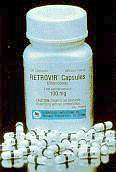| Spotlight in the Field:
The AIDS Epidemic |
|
|
In 1981
Dr. Michael Gottlieb, a doctor at the UCLA medical center, identified
five patients suffering from Pneumocystis carinii pneumonia.
The patients exhibited strikingly similar symptoms, they were active
homosexuals, aged between 29 and 36, and had almost zero T cells.
By December of 1981 270 similar cases were identified and most were
in young male homosexuals leading officials to name the disease
Gay Related Immunodeficiency Disease (GRID). However, as epidemiological
studies progressed and the disease spread, experts discovered that
GRID did not occur in just homosexuals. In fact, by the end of 1982
42% of the 788 cases could not be attributed to homosexual activity,
drug use, or blood transfusions.
|
|
|
Despite
the increasing spread of AIDS, experts remained unsure of the causative
virus that resulted in AIDS. Dr. Luc Montagnier, from England showed
convincing evidence that the causative agent was lympadenopathy-associated
virus (LAV), however, Dr. Gallo, of the National Cancer Institute,
claimed the virus was most closely related to Human T Lymphotrophic
Virus-1 (HTLV-1). The debate continued to rage until Dr. Gallo and
the Secretary of the Health and Human Services announced that HTLV-III,
a strain closely related strain HTLV-I, was the cause of AIDS in
North America. Dr. Montagnier and the Pasteur Institute continued
to claim that LAV caused AIDS and by 1985 research showed that LAV
and HTLV-III were genetically identical. Later, the Center for Disease
Control (CDC) would show that 90% of all AIDS patients had antibodies
for LAV. Also, in 1985 Dr. Jay Levy demonstrated that a distinct
retrovirus, called AIDS-Associated Retrovirus (ARV), caused AIDS
in a significant population of gay men. Officials
renamed HTLV-III, LAV, and ARV to Human Immunodeficiency Virus (HIV).
|
 |
In
1986 Zidovudine (AZT) was demonstrated to have antiretroviral capabilities
specifically targeted at the HIV virus and by 1987 the Food and
Drug Administration (FDA) approved the use of AZT in the United
States. Still the number of AIDS cases rose; 62,811 cases were reported
in over 127 different countries. Numerous countries began coordinated
education campaigns in the 80's to prevent the spread of AIDS. The
United States, however, was the last Western industrialized country
to make such an effort. President Reagan made the first public address
on the AIDS epidemic, at which point 20,000 Americans were already
claimed by the virus. In 1987 the Surgeon General issued a pamphlet
which was distributed throughout the United States describing the
methods
of transmission and precautions. Still employers and institutions
continued to discriminate against individuals with AIDS claiming
they were a liability.
|
|
In
1990 Ryan White, a hemophiliac and AIDS patient was not allowed
to attend public schools died. His death inspired congress to pass
the CARE Act, which was aimed to provide quality health care to
AIDS patients without adequate insurance. By the end of 1990 there
were 9 million projected HIV patients world wide and 1 million AIDS
patients. Among the most famous cases were Ervine (Magic) Johnson
and Arthur Ashe who declared they had AIDS in 1992 and 1993 respectively.
AIDS became the leading cause of death in 1994 with more than 250,000
deaths and 440,000 AIDS cases. At the same time scientists produced
increasing drugs against HIV, including the discovery that three
different types of drugs, which act at different sites of the virus,
were more effective than one drug. Despite the new drug therapies
and increasing optimism the number of AIDS cases continued to climb.
By 1997 it was estimated that nearly 2.7 million people died of
AIDS and 30 million people had contracted the disease.
|
|

